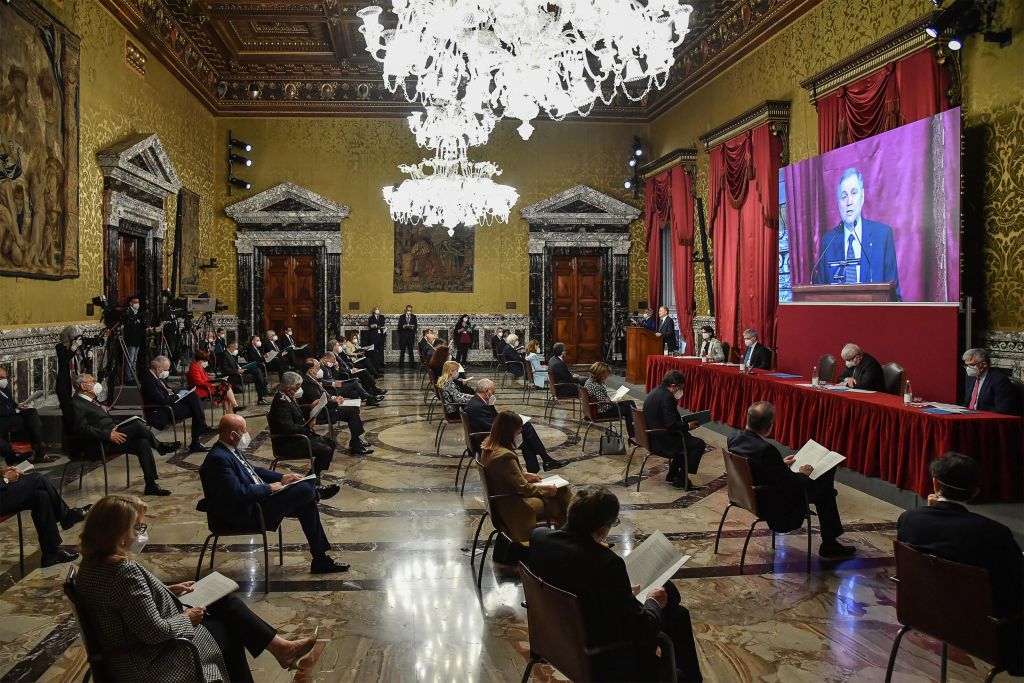A top central banker has warned of the damage the rush to ‘Net-Zero’ risks doing to Europe’s economy, and illustrates the point by noting erasing Europe’s built heritage would be necessary to meet extreme green demands.
Among comments by Paolo Angelini, deputy governor at the Bank of Italy about European Net Zero targets which, in his opinion, risk doing more harm than good, the central banker articulated what level of change would actually be needed from Europeans to meet those demands.
While saying pushing Europe to net zero risks destabilising the continent’s economy and undermining Europe’s ability to lead on green issues globally, the top economist made his point by revealing he’d asked his team at the Bank of Italy what would be necessary just to make the single institution that he leads compliant.

Shareholders’ room at the Bank of Italy on May 29, 2020 (Photo by ALESSANDRO DI MEO/POOL/AFP via Getty Images)
Angelini revealed the shocking response, remarking in an interview with Politico: “They told me: ‘If you allow us to tear down all our historical buildings and build energy efficient ones, then we can do it’.”
The Bank of Italy wouldn’t be committing itself to net zero any time soon, said Angelini. This was not because he didn’t believe in the cause, but simply because with the technology presently available, he didn’t think it was physically possible. He said: “For the time being I am refraining from raising my hand and saying at the Bank of Italy we’re going to net zero, because I don’t have the technology, the ability to be certain about the pledge.”
Reflecting on the central banker’s remarks — which may possibly have been tongue-in-cheek — Politico itself mused: “it’s a potent symbol of the trade-offs that the green transition demands: how much of Europe’s present — and past — is it willing to risk to secure its future?”.
The Bank of Italy itself is headquartered in the Palazzo Koch in Italy, an impressively grand 19th-century palace named for its architect which features a money museum and significant interiors and staterooms.
French Govt Wanted Modernist Notre Dame Rebuild, Macron’s Wife Proposed ‘Erect Phallus and Golden Balls’ Spire https://t.co/jIHlgYME5p
— Breitbart London (@BreitbartLondon) January 7, 2023
While study after study shows the general public far prefers traditional architecture, the matter does fall on partisan lines to some degree. U.S. President Donald Trump signed an order requiring a classical architectural style (Roman or Greek revival) for Federal buildings: President Biden revoked it. In the United Kingdom, an advisor to hard-left London mayor Sadiq Khan said traditional architecture is “offensive” because it, in her view, “harks back to oppression”.
The French government wanted a modernist rebuild of Notre Dame Cathedral after the devastating fire in 2019, and fought a sustained battle against traditionalists in parliament and the public to get their vision. In the end, the traditionalists won a full historic rebuild.
While net-zero extremists could demolish historic buildings with promises of more environmentally friendly modern replacements, it isn’t as if architects today have the answers. As previously reported, recent modern grand projects to create homes for large governmental organisations have run considerably over budget and over time compared to their traditional architecture alternatives.
In One particularly egregious case, the Scottish Parliament cost four times its budget and has needed remedial work on its roof since, as the aggressively modernist design failed to meet the most basic and ancient requirement for a building: that it keeps the rain out.
Lane: Only Modernist Architects Will Benefit From Moving the House of Lords to Beautiful City of York https://t.co/kq6FyZrVsZ
— Breitbart London (@BreitbartLondon) January 20, 2020


